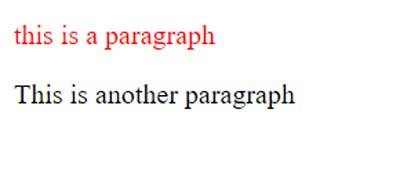Child selectors differ from descendant selectors in that they allow only elements of the first level of nesting to be selected. For example:
<h2>Child selectors:CSS </h2> <div> <p>This is a paragraph</p> </div>
Although there are as many as three elements nested in the body element – h2, div, p, but only two of them are children – div and h2, since they are in the first nesting level. And the p element is at the second nesting level, because it is nested inside a div element, and not just a body element.
An angle bracket character is used to refer to child elements:
<!DOCTYPE html>
<html lang="en">
<head>
<meta charset="UTF-8">
<meta http-equiv="X-UA-Compatible" content="IE=edge">
<meta name="viewport" content="width=device-width, initial-scale=1.0">
<title>Child selectors: CSS3</title>
<style>
.article>p {
color: red;
}
</style>
</head>
<body>
<div class="article">
<p>this is a paragraph</p>
<div class="content">
<p>This is another paragraph</p>
</div>
</div>
</body>
</html>
The block with the article class has two paragraphs. The selector .article > pselects only those paragraphs that are directly in the article block:

If we were to use another selector without the > symbol
<!DOCTYPE html>
<html lang="en">
<head>
<meta charset="UTF-8">
<meta http-equiv="X-UA-Compatible" content="IE=edge">
<meta name="viewport" content="width=device-width, initial-scale=1.0">
<title>Child selectors: CSS3</title>
<style>
.article p {
color: red;
}
</style>
</head>
<body>
<div class="article">
<p>this is a paragraph</p>
<div class="content">
<p>This is another paragraph</p>
</div>
</div>
</body>
</html>
Then the style would apply to all paragraphs at all levels of nesting:

